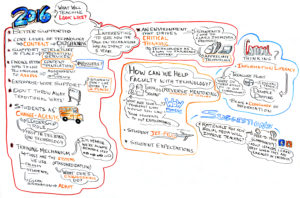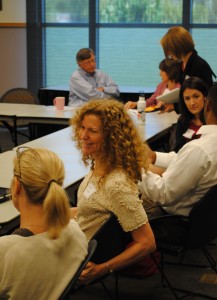Responding to Changing Technologies – A Report from the CFT’s 25th Anniversary Symposium
by Derek Bruff, CFT Acting Director
In my last post, I shared some highlights from the first hour of our discussion of changing technologies at the CFT’s 25th anniversary symposium earlier this month. The discussion raised several challenges in responding to our changing technological world, including: meeting student expectations for technology use in higher education, using educational technology that reflects our institutional values, teaching students to be critical consumers of online information, and providing faculty with the tech support they need to implement new technologies in their teaching.
In the second hour of the discussion, we moved from exploring challenges to suggesting strategies for addressing those challenges. Here are some interesting observations and bright ideas:
- In response to the question “What should teaching with technology look like five years from now, in 2016?” participants suggested that technology would provide individualized assessment of student learning, with feedback provided to both students and faculty. A core set of flexible technology tools would be used across the university. These tools would promote critical thinking and a kind of comfort with ambiguity among students. Not everything would be different; some tools currently in use would still be vital options for faculty. Tech support would be strong, with online, face-to-face, and just-in-time options.
- How to realize that vision? One suggestion that I found valuable was to use students as change agents. One participant shared that when he wants to help faculty understand why they might want to use technology in new and creative ways in their teaching, he has students share the ways they use technology in their daily lives. Faculty are often surprised by the extent to which technology is integrated in their students’ lives, and this motivates faculty to consider greater integration of technology in their teaching. (This would be what Ken Bain called an “expectation failure” in his keynote.)
- Another suggestion was to partner faculty with technologists who could provide production services, such as audio and video content creation and migration of analog content into digital forms. Some of these technologists, perhaps with experience in particular disciplines, might also partner with faculty to create domain-specific applications for faculty, such as smart phone apps that guide students interactively through particular content areas. It was clear from the technologists in the room that they’re interested in helping faculty identify, learn, and use technologies that support the faculty member’s course objectives. Students might be enlisted to provide some of this tech support, as well.
 The idea that Vanderbilt might identify a set of educational technologies as somehow “core” to its teaching mission was an exciting one. Suppose that instructors could adopt a “core” technology and know that tech support staff trained in that technology would be available for assistance. By focusing on a relatively narrow set of technologies, tech support could learn those technologies very well and not feel that they need to be experts in every possible educational technology. Faculty, in turn, would benefit from experienced tech support. Students, for their part, might not need to learn a different set of technologies for every course they took. And a “core” set of technologies would make more practical the orientation of new faculty and students to technology use at Vanderbilt.
The idea that Vanderbilt might identify a set of educational technologies as somehow “core” to its teaching mission was an exciting one. Suppose that instructors could adopt a “core” technology and know that tech support staff trained in that technology would be available for assistance. By focusing on a relatively narrow set of technologies, tech support could learn those technologies very well and not feel that they need to be experts in every possible educational technology. Faculty, in turn, would benefit from experienced tech support. Students, for their part, might not need to learn a different set of technologies for every course they took. And a “core” set of technologies would make more practical the orientation of new faculty and students to technology use at Vanderbilt.- What about the idea that our technology use at Vanderbilt should support the building of community here? A few participants pointed to social media, like the micro-blogging service Twitter or the bookmarking service Diigo. These platforms, like Common Place, mentioned in the first hour, are design to foster and enhance community. Might social media be particularly appropriate technologies to use with Vanderbilt classes? Check back here on the blog soon for a guest post by a faculty member doing just that.
- How to address the need to teach students information literacy that was surfaced in the first hour of the discussion? No clear answers to this question emerged, but it was acknowledged as an important one and a few ideas were floated. Perhaps a college could offer a course that included information literacy as an explicit learning goal and that satisfied a general education requirement. Although not all students in that college would take the course, many would. Other participants suggested that the teaching of information literacy should be embedded in the disciplines and thus, in the majors. Information literacy in sociology is not quite the same as it is in history or engineering, for instance. A participant from the Dean of Students Office pointed out that students have co-curricular opportunities for enhancing their information literacy, as well.
What’s next from the Center for Teaching on this topic? On October 27th, we’re hosting a conversation among faculty and students about student expectations for academic technology. You’re invited to join us for that discussion, which promises to be a rich one. Also this fall, we’re hoping to work with some campus partners to host other conversations aimed at helping us better understand the ways that students learn through technology outside of the classroom. If you’d like to be involved in these conversations, please let us know.
I found it fascinating how the one student in our breakout discussion described the ways she uses technology, and I believe that if we gather more student perspectives on this topic, we’ll be in a better position to respond to the challenges raised at the symposium. I hope you’ll join us in this work.
Visual notes for the technology discussion provided by Nick Navatta, Alphachimp Studios.

Leave a Response